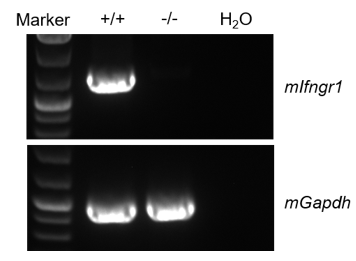B-Ifngr1 KO mice(129S2)
| Strain Name |
129S2/SvPasCrl-Ifngr1tm1Bcgen/Bcgen
|
Common Name | B-Ifngr1 KO mice(129S2) |
| Background | 129S2/SvPasCrl | Catalog number | 113252 |
|
Related Genes |
CD119, IFNGR, IMD27A, IMD27B | ||
|
NCBI Gene ID |
3459 | ||
- IFNGR1 encodes the ligand-binding chain (alpha) of the gamma interferon receptor. Human interferon-gamma receptor is a heterodimer of IFNGR1 and IFNGR2. The importance of IFNG in the immune systems in part from its ability to inhibit viral replication directly, and most importantly from its immunostimulatory and immunomodulatory effects.
- The knock-out mice developed normally.
- This model is useful in studying the role of IFN pathways in anti-viral and anti-microbial infections.

Strain specific analysis of Ifngr1 mRNA expression in wild-type 129S2 mice and B-Ifngr1 KO mice(129S2) by RT-PCR. Spleen RNA were isolated from wild-type 129S2 mice (+/+) and homozygous B-Ifngr1 KO mice(129S2) (-/-), then cDNA libraries were synthesized by reverse transcription, followed by PCR with mouse Ifngr1 primers. Mouse Ifngr1 mRNA was only detectable in wild-type mice, but not in B-Ifngr1 KO mice(129S2).

IFNGR1 expression analysis in wild-type 129S2 mice and homozygous B-Ifngr1 KO mice by flow cytometry. Blood were collected from wild-type 129S2 mice (+/+) and homozygous B-Ifngr1 KO mice (-/-). Protein expression was analyzed with anti-mouse IFNGR1 antibody (eBioscience, 12-1191-80) by flow cytometry. Wild-type C57BL/6N mice was used as a positive control for analysis. Mouse IFNGR1 was detectable in granulocytes, DC cells, B cells and macrophages from wild-type 129S2 mice, but not in those cell types from B-Ifngr1 KO mice(129S2).

IFNGR1 expression analysis in wild-type 129S2 mice and homozygous B-Ifngr1 KO mice by flow cytometry. Blood were collected from wild-type 129S2 mice (+/+) and homozygous B-Ifngr1 KO mice (-/-). Protein expression was analyzed with anti-mouse IFNGR1 antibody (eBioscience, 12-1191-80) by flow cytometry. Wild-type C57BL/6N mice was used as a positive control for analysis. Mouse IFNGR1 was detectable monocytes, T cells and NK cells from wild-type 129S2 mice, but not in those cell types from B-Ifngr1 KO mice(129S2).









